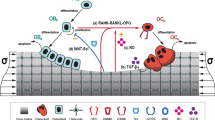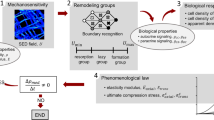Abstract
It is widely believed that mechanical forces affect trabecular bone structure and orientation. The cellular mechanisms involved in this relationship, however, are poorly understood. In earlier work we developed a theoretical, computational framework, coupling bone-cell metabolic expressions to the local mechanical effects of external bone loading. This theory is based on the assumption that osteocytes within the bone tissue control the recruitment of bone-resorbing osteoclasts and bone-forming osteoblasts, by sending strain-energy-density (SED) related signals to trabecular surfaces through the osteocytic, canalicular network. The theory explains the known morphological effects of external bone-loading variations in magnitude and frequency. It also explains the development of osteoporosis, as an effect of increased osteoclast resorption due to estrogen deficiency in postmenopausal women, and to reduced physical activity levels in general. However, the theory uses lumped variables to represent the mechanisms of osteocyte mechano-sensing and signaling. The question is whether these mechanisms could not be specified in a more realistic way. On the one hand, anabolic osteocyte signals might be triggered by the local mechanical loading variables they experience directly, as we assumed in our original theory. On the other hand, osteocyte signals might be triggered by fluid flow in the osteocytic network at large, as was suggested by others. For that purpose we compared the effects of SED, maximal principal strain and volumetric strain as representing local loading variables, to their spatial gradients on the morphological predictions of our computational model. We found that, in concept, they all produced reasonable trabecular structures. However, the predicted trabecular morphologies based on SED as the triggering variable were more realistic in dimensions and relevant metabolic parameters.
Similar content being viewed by others
References
Bertram, J. E., and S. M. Swartz. The ‘law of bone transformation’: A case of crying Wolff? Biol. Rev. Camb. Philos. Soc. 66:245–273, 1991.
Brand, R. A., C. M. Stanford, and D. P. Nicolella. Primary adult human bone cells do not respond to tissue (continuum) level strains. J. Orthop. Sci. 6:3295–301, 2001.
Bronckers, A. L. J. J., W. Goei, G. Luo, G. Karsenty, R. N. D’Souza, D. M. Lyaruu, and E. H. Burger. DNA fragmentation during bone formation in neonatal rodents assessed by transferase-mediated end labeling. J. Bone Miner. Res. 11:1281–1291, 1996.
Burger, E. H., and J. Klein-Nulend. Mechanosensory transduction in bone—role of the lacuno-canalicular network. FASEB J. 13:S101–S112, 1999.
Chambers, T. J. The direct and indirect effects of estrogen on bone formation. Adv. Organ. Biol. 5B:627–638, 1998.
Chow, J. W., A. J. Wilson, T. J. Chambers, and S. W. Fox. Mechanical loading stimulates bone formation by reactivation of bone lining cells in 13-week-old rats. J. Bone Miner. Res. 13:1760–1767, 1998.
Courteix, D., E. Lespessailles, S. Loiseau Peres, P. Obert, P. Germain, and C. L. Benhamou. Effects of physical training on bone mineral density in prepubertal girls: a comparative study between impact-loading and non-impact-loading sports. Osteoporos. Int. 8:152–158, 1998.
Cowin, S. C., L. Moss-Salentijn, and M. L. Moss. Candidates for the mechanosensory system in bone. J. Biomech. Eng. 113:191–197, 1991.
Currey, J. D. The effect of porosity and mineral content on the Young’s modulus of elasticity of compact bone. J. Biomech. 21:131–139, 1988.
Dobnig, H., and R. T. Turner. Evidence that intermittent treatment with parathyroid hormone increases bone formation in aged rats by activation of bone lining cells to osteoblasts. Endocrinology136:3632–3638, 1995.
Eriksen, E. F., and M. Kassem. The Cellular basis of bone remodeling. In: Triangle 31 Sandoz J. of Med. Sc., The changing architecture of the skeleton. pp 45–57, 1992.
Frost, H. M. Skeletal structural adaptations to mechanical usage (SATMU): 1. Redefining Wolff’s Law: The bone modelling problem. Anat. Rec. 226:403–413, 1990.
Frost, H. M. Skeletal structural adaptations to mechanical usage (SATMU): 2. Redefining Wolff’s Law: The remodeling problem. Anat. Rec. 226:414–422, 1990.
Guldberg, R. E., M. Richards, N. J. Caldwell, C. L. Kuelske, and S. A. Goldstein. Mechanical stimulation of tissue repair in the hydraulic bone chamber. J. Bone Miner. Res. 12:1295–1302, 1997.
Han, Z. H., S. Palnitkar, D. S. Rao, D. Nelson, and A. M. Parfitt. Effects of ethnicity and age or menopause on the remodeling and turnover of iliac bone: Implications for mechanisms of bone loss. J. Bone Miner. Res. 12:498–508, 1997.
Huiskes, R., R. Ruimerman, G. H. van Lenthe, and J. D. Janssen. Effects of mechanical forces on maintenance and adaptation of form in trabecular bone. Nature 405:704–706, 2000.
Jee, W. S. S., and X. J. Li. Adaptation of cancellous bone to overloading in the adult rat: A single photon absorptiometry and histomorphometry study. Anat. Rec. 227:418–426, 1990.
Jee, W. S. S. Integrated bone tissue physiology: Anatomy and physiology. In: Bone Mechanics Handbook, S. C. Cowin. London: CRC Press, 2001, pp. 1.1–1.68.
Kanis, J. A. Osteoporosis, Blackwell Healthcare Communications, 1997.
Klein-Nulend, J., A. van derPlas, C. M. Semeins, N. E. Ajubi, J. A. Frangos, P. J. Nijweide, and E. H. Burger. Sensitivity of osteocytes to biomechanical stress in vitro. FASEB J. 9:441–445, 1995.
Knothe Tate, M. L., and M. B. Schaffler. Loss of Osteocyte Integrity Colocolizes with Bone Resorption Following Disuse. Trans. 48th Ann. meeting of the Orthop Res Society, Dallas, Texas, 2002.
Kufahl, R. H., and S. Saha. A theoretical model for stress-generated fluid flow in the canaliculi-lacunae network in bone tissue. J. Biomech. 23:171–180, 1990.
Li, C. Y., D. Laudier, and M. B. Schaffler. Remobilization restores cancellous bone mass but not microarchitecture after long term disuse in older adult dogs. Trans. 49th Ann. meeting of the Orthop Res Society}, New Orleans, LA, 2003.
Martin, R. B. Towards a unifying theory of bone remodeling. Bone 26:1–6, 2000.
McNamara, L. M., J. C. van der Linden, H. Weinans, P. J. Prendergast. High stresses occur in bone trabeculae under low loads A study using micro-serial sectioning techniques and finite element analysis. Proceedings of the 13th Conference of the ESB, Wroclow, Poland, 2002.
Mosekilde, L. Consequences of the remodeling process for vertebral trabecular bone structure: A scanning electron microscopy study (uncoupling of unloaded structures). Bone Miner. 10:13–35, 1990.
Mullender, M. G., and R. Huiskes. A proposal for the regulatory mechanism of Wolff’s law. J. Orthop. Res. 13:503–512, 1995.
Mullender, M. G., R. Huiskes, H. Versleyen, and P. Buma. Osteocyte density and histomorphometric parameters in cancellous bone of the proximal femur in five mammalian species. J. Orthop. Res. 14:972–979, 1996.
Nicolella, D., and J. Lankford. Strain Concentration Effects of Osteocyte Lacunae. Trans. 48th Ann. meeting of the Orthop Res Society, Dallas, Texas, 2002.
Noble, B. S., H. Stevens, N. Loveridge, and J. Reeve. Identification of apoptotic changes in osteocytes in normal and pathological human bone. Bone 20:273–182, 1997.
Parfitt, A. M., C. H. E. Mathews, A. R. Villanueva, and M. Kleerekoper. Relationships between surface, volume, and thickness of iliac trabecular bone in aging and in osteoporosis. J. Clin. Invest. 72:1396–1409, 1983.
Parfitt, A. M., M. K. Drezner, F. H. Glorieux, J. A. Kanis, H. Malluche, P. J. Meunier, S. M. Ott, and R. R. Recker. Bone histomorphometry: Standardization of nomenclature, symbols, and units. Report of the ASBMR histomorphometry nomenclature committee. J. Bone Miner. Res. 2:595–610, 1987.
Rodan, G. A. Mechanical loading, estrogen deficiency, and coupling of bone formation to bone resorption. J. Bone Miner. Res. 6:527–530, 1991.
Ruimerman, R., R. Huiskes, G. H. van Lenthe, and J. D. Janssen. A computer-simulation model relating bone-cell metabolism, to mechanical adaptation of trabecular bone. Comput. Methods Biomech. Biomed. Engin. 4:433–448, 2001.
Ruimerman, R., P. Hilbers, B. van Rietbergen, and R. Huiskes. Indirect osteoblast-osteoclast coupling through mechanics explains elevated osteoblastic bone formation as a response to increased osteoclastic activity. Trans. 49th Ann. meeting of the Orthop Res Society, New Orleans, LA, 2003.
Ruimerman, R., P. Hilbers, B. van Rietbergen, and R. Huiskes. A theoretical framework for strain-related trabecular bone maintenance and adaptation. J. Biomech. In press.
Skerry, T. M., L. Bitensky, J. Chayen, and L. E. Lanyon. Early strain-related changes in enzyme activity in osteocytes following bone loading in vivo. J. Bone Miner. Res. 4:783–788, 1989.
Tanck, E., J. Homminga, G. H. van Lenthe, and R. Huiskes. Increase in bone volume fraction precedes architectural adaptation in growing bone. Bone 28:650–654, 2001.
Verborgt, O., G. J. Gibson, and M. B. Schaffler. Loss of osteocyte integrity in association with microdamage and bone remodeling after fatigue In vivo. J. Bone Miner. Res. 15:60–67, 2000.
Weinbaum, S., S. C. Cowin, and Y. Zeng. A model for the excitation of osteocytes by mechanical loading-induced bone fluid shear stresses. J. Biomech. 27:339–360, 1994.
Wolff, J. Das Gesetz der Transformation der Knochen. Berlin A. Hirchwild (1892) Translated as: The Law of Bone Remodeling edited by Maquet P., and R. Furlong, Berlin: Springer-Verlag, 1986.
You, L., S. C. Cowin, M. B. Schaffler, and S. Weinbaum. A model for strain amplification in the actin cytoskeleton of osteocytes due to fluid drag on pericellular matrix. J. Biomech. 34:1375–1386, 2001.
Zerwekh, J. E., L. A. Ruml, F. Gottschalk, and C. Y. C. Pak. The effects of twelve weeks of bed rest on bone histology, biochemical markers of bone turnover, and calcium homeostasis in eleven normal subjects. J. Bone Miner. Res. 13:1594–1601, 1998.
Author information
Authors and Affiliations
Corresponding author
Rights and permissions
About this article
Cite this article
Ruimerman, R., van Rietbergen, B., Hilbers, P. et al. The Effects of Trabecular-Bone Loading Variables on the Surface Signaling Potential for Bone Remodeling and Adaptation. Ann Biomed Eng 33, 71–78 (2005). https://doi.org/10.1007/s10439-005-8964-9
Issue Date:
DOI: https://doi.org/10.1007/s10439-005-8964-9




